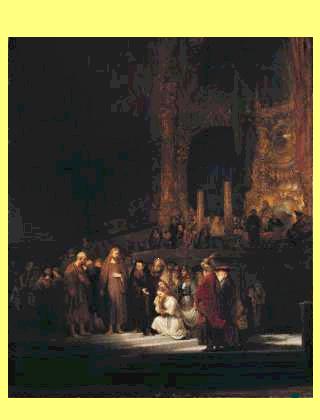The Woman Taken in AdulteryI find this, like one other in my gallery (The Sacrifice of Isaac), to be among the most evocative themes ever rendered into the visual medium. The imagery inherent in the situation; the woman standing alone and defenceless before her accusers who suddenly find that they must, perforce, accuse themselves and drift silently and shamefacedly away while Jesus doodles on the ground only to find on looking up in mock surprise that only the woman remains. One can almost hear the verses being spoken in a modern setting with modern idioms; such a down-to-earth situation and drama - such an overpowering emotive and moral message conveyed in less than four dozen words: "When Jesus had lifted himself up, and saw none but the woman, he said unto her, Woman, where are those thine accusers? hath no man condemned thee? She said, No man, Lord. And Jesus said unto her, Neither do I condemn thee: go, and sin no more. (John VIII: 10-11).
This painting by Rembrandt is dated 1644 although scholars are of the opinion that it belongs more, by its colour and style, to a period in the artist's life ten years earlier.
My sincere gratitude, again, to The National Gallery, Trafalgar Square, London, for their warm hospitality and kindness in allowing me free access to their site for this work of art.
